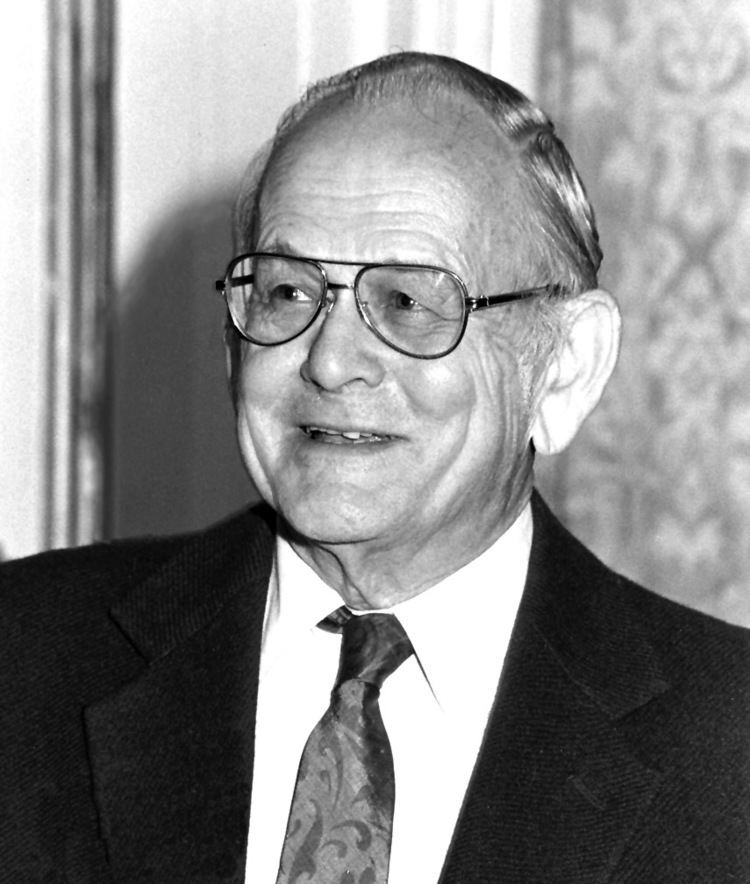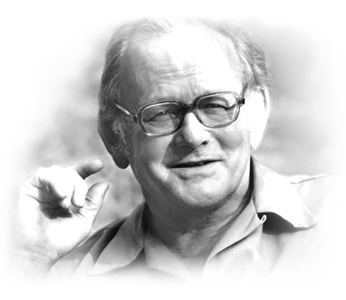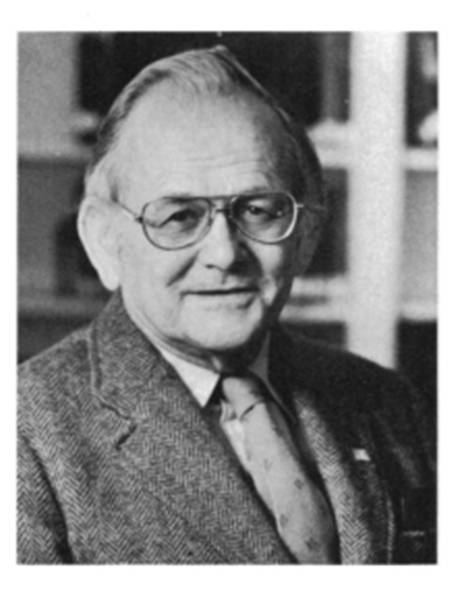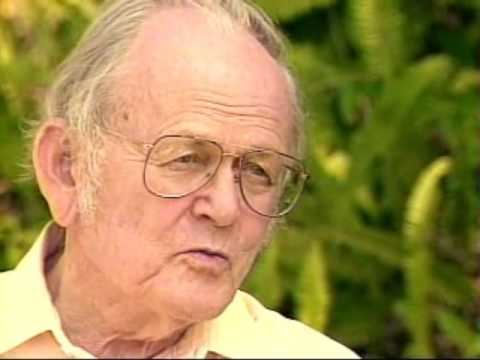Name Garrett Hardin Role Ecologist | ||
 | ||
Books Living Within Limits: Ec, Filters against folly, The Ostrich Factor, Nature and man's fate, Stalking the wild taboo | ||
Garrett hardin on overpopulation and carrying capacity
Garrett James Hardin (April 21, 1915 – September 14, 2003) was an American ecologist and philosopher who warned of the dangers of overpopulation. His exposition of the tragedy of the commons, in a famous 1968 paper in Science, called attention to "the damage that innocent actions by individuals can inflict on the environment". He is also known for Hardin's First Law of Human Ecology: "We can never do merely one thing. Any intrusion into nature has numerous effects, many of which are unpredictable."
Contents
- Garrett hardin on overpopulation and carrying capacity
- Garrett hardin on growth limits and a better world
- Biography
- Major works and positions
- Neomalthusian approach and Tragedy of the commons
- Lifeboat metaphor and denial of food aid
- Living Within Limits
- Position in the Bell curve controversy and against affirmative action
- Participation in the Death with dignity movement and suicide
- Books
- Selected journal articles
- Chapters in books
- Awards
- References

Garrett hardin on growth limits and a better world
Biography

Hardin received a B.S. in zoology from the University of Chicago in 1936 and a PhD in microbiology from Stanford University in 1941 where his dissertation research addressed symbiosis among microorganisms. Moving to the University of California, Santa Barbara in 1946, he served there as Professor of Human Ecology from 1963 until his (nominal) retirement in 1978. He was among the first members of the Society for General Systems Research.
Major works and positions

A major focus of his career, and one to which he returned repeatedly, was the issue of human overpopulation. This led to writings on controversial subjects such as advocating abortion rights, which earned him criticism from the political right, and advocating eugenics by forced sterilization, and strict limits to non-western immigration, which earned him criticism from the political left. In his essays, he also tackled subjects such as conservation and creationism.
Neomalthusian approach and "Tragedy of the commons"
In 1968 Hardin applied his conceptual model developed in his essay "The tragedy of the commons" to human population growth, the use of the Earth's natural resources, and the welfare state. His essay cited an 1833 pamphlet by the English economist William Forster Lloyd which included an example of herders sharing a common parcel of land, which would lead to overgrazing.
Hardin blamed the welfare state for allowing the tragedy of the commons; where the state provides for children and supports over-breeding as a fundamental human right, Malthusian catastrophe is inevitable. Hardin stated in his analysis of the tragedy of the commons that "Freedom in a commons brings ruin to all." However, environmental historians Joachim Radkau, Alfred Thomas Grove and Oliver Rackham denounced Hardin "as an American with no notion at all how Commons actually work".
In addition, Hardin's pessimistic outlook was in contradiction with Elinor Ostrom's later work on success of co-operative structures like the management of common land, for which she shared the 2009 Nobel Memorial Prize in Economic Sciences together with Oliver E. Williamson. In contrast to Hardin, they stated neither commons or "Allmende" in the generic nor classical meaning are bound to fail; to the contrary "the wealth of the commons" has gained renewed interest in the scientific community. Hardin's work was also criticized as historically inaccurate in failing to account for the demographic transition, and for failing to distinguish between common property and open access resources.
It should be noted that Lloyd's original example, re-discovered by Hardin, could only apply to unregulated use of land regarded as a common resource. Normally, rights of use of Common land in England and Wales were, and still are, closely regulated, and available only to "commoners". If excessive use was made of common land, for example in overgrazing, a common would be "stinted", that is, a limit would be put on the number of animals each commoner was allowed to graze. These regulations were responsive to demographic and economic pressure; thus rather than let a common become degraded, access was restricted even further. Controls on usage can help mitigate the tragedy of the commons.
Lifeboat metaphor and denial of food aid
In September 1974, he published the article "Living on a Lifeboat" in BioScience magazine, arguing that contributing food to help the Ethiopian famine would add to overpopulation, which he considered the root of Ethiopia's problems.
Living Within Limits
In 1993, Garrett Hardin published Living Within Limits: Ecology, Economics, and Population Taboos, which he described at the time as a summation of all his previous works. The book won the 1993 Phi Beta Kappa Award in Science. In the book, he argues that the natural sciences are grounded in the concept of limits (such as the speed of light), while social sciences, such as economics, are grounded in concepts that have no limits (such as the wide-spread "infinite-Earth" economic models). He notes that most of the more notable scientific (as opposed to political) debates concerning ecological economics are between natural scientists, such as Paul R. Ehrlich, and economists, such as Julian Simon, one of Ehrlich's most well known and vocal detractors. A strong theme through out the book is that economics, as a discipline, can be as much about mythology and ideology as it is about real science.
Hardin goes on to label those who reflexively argue for growth as "growthmaniacs", and argues against the institutional faith in exponential growth on a finite planet. Typical of Hardin's writing style, he illustrates exponential growth by way of a Biblical metaphor. Using compound interest, or "usury", he starts from the infamous "thirty pieces of silver" and, using 5% compounded interest, finds that after around 2,000 years, "every man, woman, and child would be entitled to only (!) 160,000 earth-masses of gold". As a consequence, he argues that any economy based on long-term compound interest must eventually fail due to the physical and mathematical impossibility of long-term exponential growth on a finite planet. Hardin writes, "At this late date millions of people believe in the fertility of money with an ardor seldom accorded to traditional religious doctrines". He argues that, contrary to some socially-motivated claims, population growth is also exponential growth, therefore even a little would be disastrous anywhere in the world, and that even the richest nations are not immune.
Position in the Bell curve controversy and against affirmative action
In 1994, he was one of 52 signatories on "Mainstream Science on Intelligence", an editorial written by Linda Gottfredson and published in the Wall Street Journal, which declared the consensus of the signing scholars on issues related to race and intelligence following the publication of the book The Bell Curve. Like many of the other signatories of that editorial, Hardin was also a grantee of the Pioneer Fund, which funds controversial research on the topic of race and intelligence and is frequently described as promoting scientific racism. On February 11, 1998, he debated Christian philosopher William Lane Craig at the University of California, Santa Barbara.
Hardin's last book The Ostrich Factor: Our Population Myopia (1999), a warning about the threat of overpopulation to the Earth's sustainable economic future, called for coercive constraints on "unqualified reproductive rights" and argued that affirmative action is a form of racism.
Participation in the Death with dignity movement and suicide
Hardin, who suffered from a heart disorder and the aftermath of childhood polio, and his wife Jane, who suffered from Lou Gehrig's disease, were members of End-of-Life Choices, formerly known as the Hemlock Society, and believed in individuals choosing their own time to die. They committed suicide in their Santa Barbara home in September 2003, shortly after their 62nd wedding anniversary. He was 88 and she was 81.
